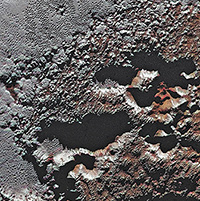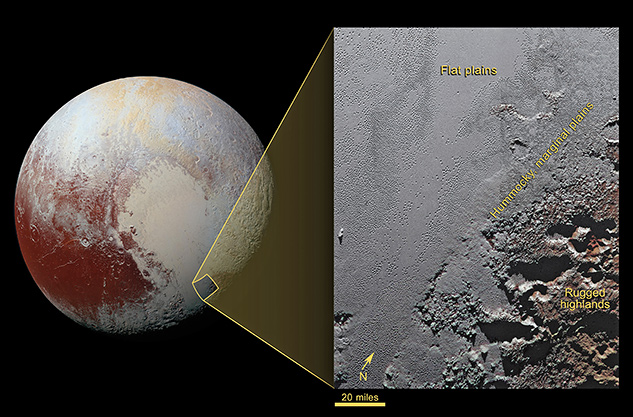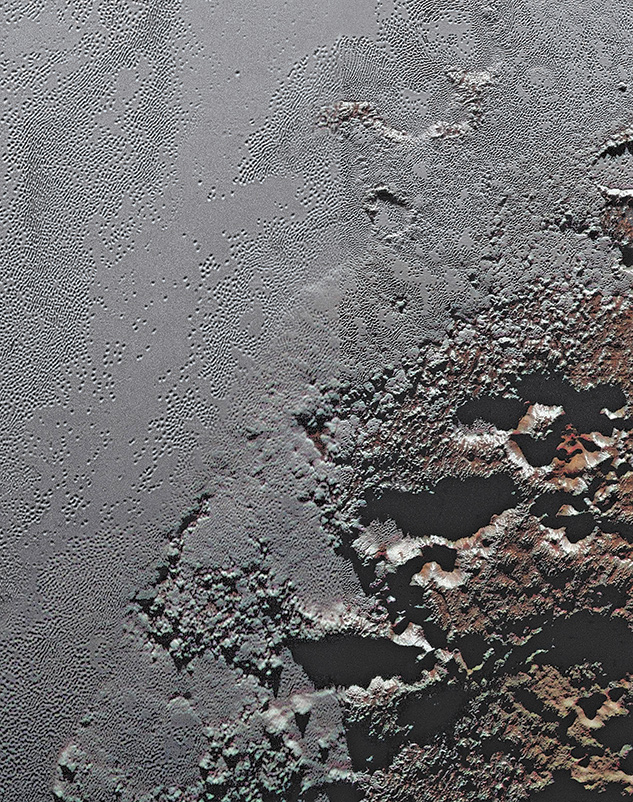When Ralph met LORRI: Check out this stunning high-resolution image of Pluto’s Krun Macula
posted Tuesday, August 23, 2016 at 7:17 AM EDT

Sometimes I think it's easy to take for granted that there really are other worlds out there, some here in our own proverbial back yard. Those of us old enough to remember the original images of the lunar surface taken by the Apollo 11 astronauts, or the mesmorizing transmissions beamed back from the Voyager missions, can recall the feeling of awe and wonder from seeing them for the first time.
In today's Instagram and Facebook world perhaps we've become so over-saturated with images in general that our collective "awe factor" has become critically low, but seeing the recent high resolution images beamed back from distant Pluto by the New Horizons spacecraft has amped mine back up. Demoted some years ago from an official "planet" to the incidental status of "dwarf planet" (indeed!), Pluto for most of us is still the last in line standing guard at the outer rim of our system.
Until Nasa's New Horizons finally reached Pluto, its surface was still all but a mystery to us, with telescopic images only suggesting faint blurs of shape. Now that we've had the chance to finally get a look at Pluto up close and personal, the actual reality of what the surface holds is far more tantalizing than what most interested planetary scientists had likely dreamed about. And while not directly related to the type of photography most of us do, I still thought it worthwhile to post an image here for anyone who's yet to explore these intriguing areas of Pluto's diverse terrain.

The image below is of a boundary between a wide, flat plain called Sputnik Planum, possibly composed of frozen nitrogen, and a craggy, mountainous area aptly dubbed Krun Macula. The icy plains seem to shift abruptly into the jagged mountainous region, with the reddish color theorized to be related to complex compounds called "tholins" possibly created from chemical reactions with methane in Pluto's atmosphere. (Incidentally, the term 'tholin' was coined by Carl Sagan and his partner after conducting experiments relating to the gas mixtures found in Titan's atmosphere.)

And as for the photography part in all this, the striking image is actually composed of three separate images taken from different vantage points in New Horizon's flight path. The right half is obtained from 260ft/80meter-per-pixel data shot at 9,850 miles (15,860 kilometers) from the surface of Pluto using the onboard camera called "LORRI" (Long Range Reconnaissance Imager). The left half was also taken by LORRI obtained with 460ft/125meter-per-pixel data shot at 15,470 miles (24,900 kilometers) distance, which together represent some of the highest resolution images yet taken of the Plutonian system.
The third image was taken by "Ralph" (a multispectral visual imaging camera) obtained using 2230ft/680meter-per-pixel data at 21,100 miles (33,900 kilometers) high, and this image's data were used to colorize the final version. That certainly sounds like a fair bit of work in the post-processing lab, but the end result seems far worth the effort, as it's likely that planetary geologists will be studying these images for decades to come.
New Horizons has now left the Plutonian system, and is ferrying Ralph and LORRI into the great beyond to try and track down a Kuiper Belt Object. The current candidate is an icy body only about 1% the size of Pluto, named KBO 2014 MU69. Assuming the mission is funded through this proposed fly-by, what an incredible opportunity we may get to see something thought to be a pristine relic of our early solar system.
(Seen via APOD)